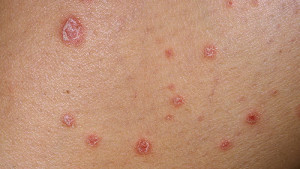Psoriasis is one of the most baffling and persistent of skin disorders, characterized by skin cells that multiply up to 10 times faster than normal. It typically occurs on the knees, elbows, and scalp and it can also affect the torso, palms, and soles of the feet.
The symptoms of psoriasis vary depending on the type. Some common symptoms for plaque psoriasis – the most common variety of the condition – include:
•Plaques of red skin, often covered with loose, silver-colored scales; these lesions may be itchy and painful, and they sometimes crack and bleed. In severe cases, the plaques of irritated skin will grow and merge into one another, covering large areas.

•Disorders of the fingernails and toe nail, including discoloration and pitting of the nails; the nails may also begin to crumble or detach from the nail bed.
Psoriasis can also be associated with psoriatic arthritis, which leads to pain and swelling in the joints. The National Psoriasis Foundation estimates that between 10% to 30% of people with psoriasis also have psoriatic arthritis.
Other forms of psoriasis include:
Pustular psoriasis, characterized by red and scaly skin on the palms of the hands and/or feet with tiny pustules
Guttate psoriasis, which often starts in childhood or young adulthood, is characterized by small, red spots, mainly on the torso and limbs. Triggers may be respiratory infections, strep throat, tonsillitis, stress, injury to the skin, and use of anti-malarial and beta-blocker medications.
Inverse psoriasis, characterized by bright red, shiny lesions that appear in skin folds, such as the armpits, groin area, and under the breasts
Erythrodermic psoriasis, characterized by periodic, fiery redness of the skin and shedding of scales in sheets; this form of psoriasis, triggered by withdrawal from a systemic psoriasis treatment, severe sunburn, infection, and certain medications, requires immediate medical treatment, because it can lead to severe illness.
People who suffer from psoriasis know that this uncomfortable and at times disfiguring skin disease can be difficult and frustrating to treat. The condition comes and goes in cycles of remissions and flare-ups over a lifetime. While there are medications and other therapies that can help to clear up the patches of red, scaly, thickened skin that are the hallmark of psoriasis, there is no cure.
What Causes Psoriasis?
A variety of factors ranging from emotional stress and trauma to streptococcal infection can cause an episode of psoriasis. Recent research indicates that some abnormality in the immune system is the key cause of psoriasis. As many as 80% of people having flare-ups report a recent emotional trauma, such as a new job or the death of a loved one. Most doctors believe such external stressors serve as triggers for an inherited defect in immune function.
Injured skin and certain drugs can aggravate psoriasis, including certain types of blood pressure medications (like beta-blockers), the anti-malarial medication hydroxychloroquine, and ibuprofen (Advil, Motrin, etc.).
Psoriasis tends to run in families, but it may be skip generations; a grandfather and his grandson may be affected, but the child’s mother never develops the disease. Although psoriasis may be stressful and embarrassing, most outbreaks are relatively harmless. With appropriate treatment, symptoms generally subside within a few months.
Treatment:
Treatment depends on the size of the psoriasis patches, type and how the patient reacts to certain treatments.
Topical Treatment (creams, ointments) may help reduce inflammation and skin cell turnover, suppress the immune system, help the skin peel and unclog pores, soothe the skin.
Systemic Treatment: If the psoriasis is severe, doctors might prescribe drugs or give medicine through a shot. Antibiotics are not used to treat psoriasis unless bacteria make the psoriasis worse
